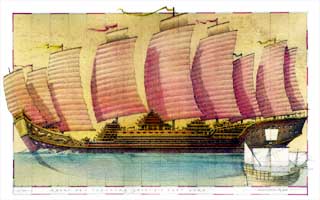Throughout human history, the expansion of technology has been dependent on the cultural environment into which it was introduced. Intricacies in social and cultural beliefs are among the reasons Europe’s technological dominance and expansion from the 15-1600’s to the early twentieth century. In addition, isolation and cultural conservatism are among the main reasons that Chinese culture, whose inventions range from paper to the wheelbarrow, never capitalized on their large technological advantage to expand their Empire. This and other examples demonstrate the need of our society to create a society that promotes not only the innovation but the adoption of new technologies.
Before delving into the diverse examples of technologies constrained by culture, we should consider the example which has become the poster child for social control of both technology and environment. According to the first chapter of Clive Ponting’s Green History of the World Easter Island flourished as a society for a thousand years starting from approximately the fifth century. Hallmarked by the large stone heads that are scattered across the island, Easter Island collapsed as a society because of the mass deforestation and destruction carried out by the islanders. The large trees that were present on Easter Island were used by the islanders for a large number of traditional applications. Large canoes were fashioned for sea fishing, bark was used for creating nets, and timber was used for building houses. The most significant technology that the trees of Easter Island were employed for was the transportation of the totemic heads that represented tribal status in the Island’s culture. Easter Island, like so many other early and modern civilizations, went about employing the environmental resources of the island around them. Within about a thousand years they had almost completely deforested Easter Island and their complex society and large population had collapsed. What is most important about Easter Island is not that a society overused its environment and collapsed; many different cultures have in the past overextended their environment and many do so today. No doubt we shall continue to do so into the future. What is prevalent about Easter Island is the reason the islanders deforested their environment. The large stone heads that the Easter Islanders employed as symbols of status in their society require trees for their transportation. More than 600 of the heads dot the landscape today and there are others left incomplete in the Easter Island quarries. But why would the Easter Islanders continue to create their monumental creations as the Easter Island environment declined. It’s highly unlikely the Easter Island forest service glanced up from its logging one day to find out that <gasp> all the trees were gone! Easter Islanders must have noticed the changes going on around them, as they ran out of trees the social changes must have been large and noticeable. They would have been unable to hunt on the ocean sea or even build wooden houses anymore. Yet why would they continue to build stone heads? Transporting them certainly requires more logs than building one canoe, the lumber to transport many could presumably used to rebuild the tribal town. Yet they continued to attempt to create their ahu. Therein lays the warning of Easter Island.
 When
they noticed the environmental degradation around them the islanders could have
curtailed the creation of the ahu, could have halted the cutting down of trees.
Instead they continued, based on a technology required by the tribal culture
that surrounded them. The culture of Easter Island placed so much emphasis on
the creation of these large status symbols, and the technology needed to erect
and transport them, that it was unable to rescue itself from the degradation
it had caused. The technology demanded by Easter Island culture, and the culture
that demanded its continued use, paved its own eradication.
When
they noticed the environmental degradation around them the islanders could have
curtailed the creation of the ahu, could have halted the cutting down of trees.
Instead they continued, based on a technology required by the tribal culture
that surrounded them. The culture of Easter Island placed so much emphasis on
the creation of these large status symbols, and the technology needed to erect
and transport them, that it was unable to rescue itself from the degradation
it had caused. The technology demanded by Easter Island culture, and the culture
that demanded its continued use, paved its own eradication.On a less somber but no less curious note I examine the influence of culture on the use and expansion of Chinese technology. The conservatism of Chinese society prohibited the mass usage of the technologies that they developed. Before I continue I should point out that when I refer to Chinese innovations I am referring to those of the entirety of the geographic area that today might be considered China. I am not positive of the specific origins of many of the technologies beyond their relative geographic location. Therefore I use the word Chinese as a catch all, aware that many different cultures within Asia were responsible for inventions I may term as Chinese. The list of those inventions is quite staggering. Among other things, Chinese civilization is responsible for the invention of paper, iron, porcelain, printing, the magnetic compass, and gunpowder (Lost Discoveries: The ancient roots of modern science, Dick Teresi, p.355). Chinese culture, perhaps owing to the relative isolation of China itself, has always been rather conservative. China believed itself to posses the perfect society and, at least in theory, was distasteful towards non-Chinese innovations. Additionally, as my 8th grade history teacher repeated ad nauseum, technology in China was considered “nifty but not necessary”. It was this close minded world view that retarded the maximization of the diverse technologies that China possessed. A prime example of the restrictive effect of culture on Chinese technology is the story of the
 fleet
of Admiral Zheng He. In the early 1400’s Admiral Zheng commanded a single
fleet of ships larger than the combined fleets of Europe at that time, a fleet
which comprised 317 ships and 37,000 men. He traveled to 37 countries and even
rounded Africa and entered the Atlantic Ocean. His voyages sparked many innovative
maritime technologies, including watertight compartments, central rudders and
new varieties of sails (http://www.oceansonline.com/zheng.htm). His flag ship
measured approximately 1.5 football fields. However, he was called back from
his journeys after 28 years in the navy, partially because of the large expense
of maintaining a fleet in the face of Mongol invasions, but also because of
political pressure in court. Opponents believed consumer ventures and expansion
alien to Chinese ideals for government. They advocated a return to society based
on agriculture. The technological advances which could have led China to world
prominence were shackled based on the beliefs of Chinese culture.
fleet
of Admiral Zheng He. In the early 1400’s Admiral Zheng commanded a single
fleet of ships larger than the combined fleets of Europe at that time, a fleet
which comprised 317 ships and 37,000 men. He traveled to 37 countries and even
rounded Africa and entered the Atlantic Ocean. His voyages sparked many innovative
maritime technologies, including watertight compartments, central rudders and
new varieties of sails (http://www.oceansonline.com/zheng.htm). His flag ship
measured approximately 1.5 football fields. However, he was called back from
his journeys after 28 years in the navy, partially because of the large expense
of maintaining a fleet in the face of Mongol invasions, but also because of
political pressure in court. Opponents believed consumer ventures and expansion
alien to Chinese ideals for government. They advocated a return to society based
on agriculture. The technological advances which could have led China to world
prominence were shackled based on the beliefs of Chinese culture. It should not be construed from this that I am in any way contemptuous of Chinese Society, nor am I particularly fond of the European culture that employed Chinese technologies to dominate the known world. However it should be noted that Chinese culture did inhibit the full utilization of the technologies that China invented, and that perhaps it was the relative instability of European culture that allowed them to employ Chinese advances so quickly. The English observed cannons being used by Arabs against Spain at the Battle of Tarifa, and within six years they used them against the French at the Battle of Crécy (Jared Diamond, Guns, Germs and Steel. 249). Some element of their culture, be it openness to new ideas, or the dominance of military considerations, or even a basic desire to kick the stuffing out of the French whatever way possible, allowed the English to recognize and utilize a new technology quickly and effectively.
Lest it be assumed that China is the only country whose country has severely hampered the expansion of its own technology, I feel I should point out some other notable examples. Guns were introduced to Japan in 1543 and by 1600 they had improved on the design to the point where Japan not only possessed better guns than any other single country, they possessed more of them (Diamond, 257). However, the supremacy of ritualized battle in Japan, as demonstrated by the Samurai and their code of honor, led to the reduction and eventual restriction of gun production in Japan. This gun embargo lasted until the arrival of William Perry’s U.S. fleet in 1853.
The common keyboard used throughout the world today, commonly known as the QWERTY keyboard for the first five letters in its top left corner, is another example of the effect culture can have on technology. It was originally developed to slow down typists, throwing commonly used letters across rows and concentrating them on the left side to force us to use our less dominant hand.
 This
was done originally because the gears of early typewrites were prone to sticking,
and slowing typists down was the best way to ensure that the typewriter remained
viable. Tests in 1932 proved that a more normally laid out keyboard would allow
us to type twice as fast and reduce the effort it takes to type by 95% ( Diamond,
248). However, by that time the QWERTY keyboard had become so entrenched in
our society that not only was it kept, it was even adopted straightforwardly
as the common keyboard to employ with computers. A completely inefficient technology
has persisted because of the cultural baggage we as a society have wrapped up
in its continued use.
This
was done originally because the gears of early typewrites were prone to sticking,
and slowing typists down was the best way to ensure that the typewriter remained
viable. Tests in 1932 proved that a more normally laid out keyboard would allow
us to type twice as fast and reduce the effort it takes to type by 95% ( Diamond,
248). However, by that time the QWERTY keyboard had become so entrenched in
our society that not only was it kept, it was even adopted straightforwardly
as the common keyboard to employ with computers. A completely inefficient technology
has persisted because of the cultural baggage we as a society have wrapped up
in its continued use.The oil crisis in the early 1970’s prefigured the massive rise of gas prices and shortages around the world. In response to the problem of low supply, Volvo decided to create a car known as the Light Component Project. The LCP used composite and lightweight materials to create a lightweight and fuel-efficient vehicle that could survive the oil crisis. The LCP ran on an extremely efficient diesel engine and averaged 65 miles per gallon, and as much as 100 mpg at cruising speeds (http://www2.rmcil.edu/satre/sci115/sci115/video6.htm). However, as the crisis eased and gas prices decreased Volvo decided not to put the car into production. Without
 high
gas prices its economic viability was very low.
high
gas prices its economic viability was very low. We have had the technology to produce fuel-efficient cars for more than 30 years. The only thing restricting us has been the force of the economy and politics. Oil companies, along with the American subsidies that make sure we get cheap oil, have ensured that the demand for cars that are inefficient has stayed high. There is no economic impetus in our society to promote the ownership of a fuel efficient car. Yet few people even know or are aware that we have the ability to create better cars. Our culture is so based on economics that it has inhibited technological innovation to the point where many people are completely unaware of our own scientific capabilities.
We are beyond the days of isolated culture. Whereas China and Japan were able to ignore the technological expansion of the rest of the world for hundreds of years, there is not remaining self-sufficient or isolated culture remaining today. The expansion of communication and trade throughout the world has resulted in what can truly be termed a pervasive global culture. We now have the ability to affect the entire globe with our technological choices, and unless we promote a culture that is both innovative and environmentally friendly we stand to cause permanent damage not only to the world around us but to ourselves as well.